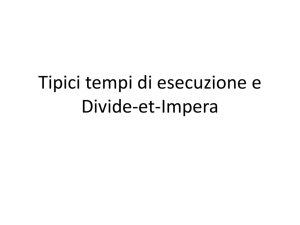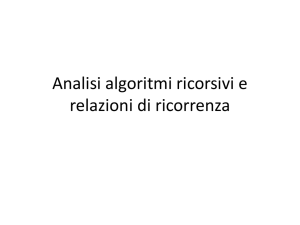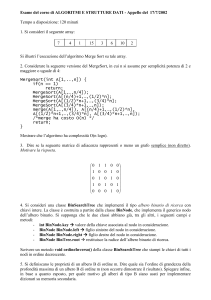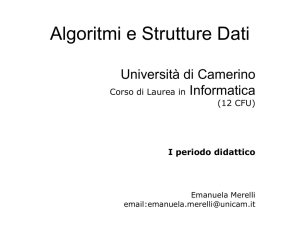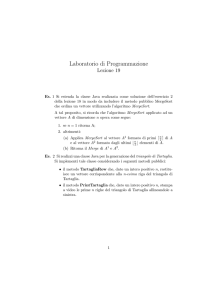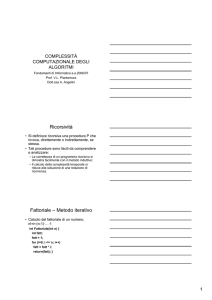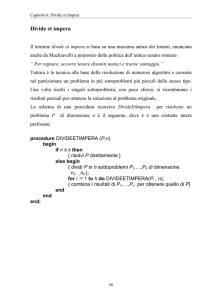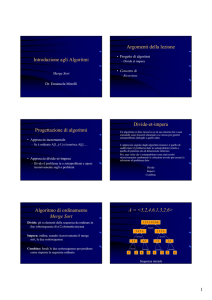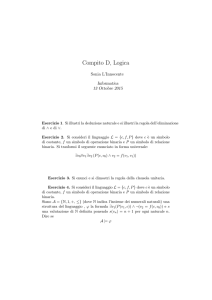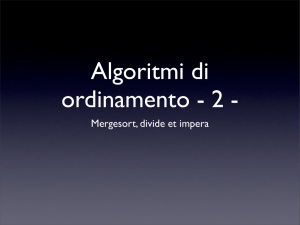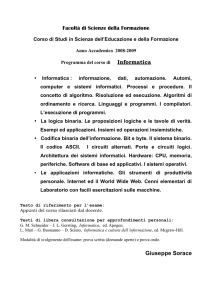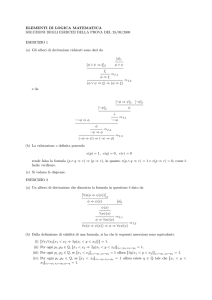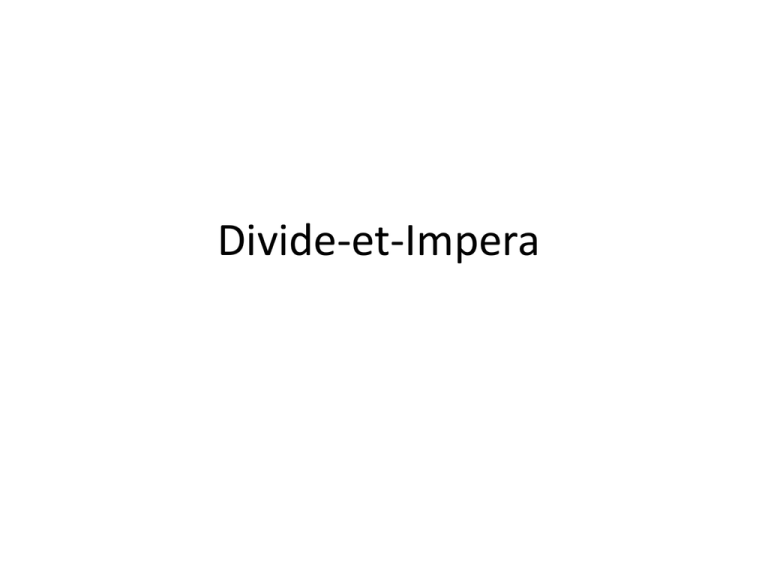
Divide-et-Impera
Divide-and-Conquer
“Divide et impera”
Giulio Cesare
Divide-and-conquer.
– Break up problem into several parts.
– Solve each part recursively.
– Combine solutions to sub-problems into overall
solution.
Examples: Binary Search, Mergesort, …..
2
Divide et impera
Divide – et - Impera
– Dividi il problema in sottoproblemi
– Risolvi ogni sottoproblema ricorsivamente
– Combina le soluzioni ai sottoproblemi per
ottenere la soluzione al problema
Esempio: Ricerca binaria:
- Dividi l’array a metà (determinando l’elemento di mezzo)
- Risolvi ricorsivamente sulla metà di destra o di sinistra o su nessuna
(a secondo del confronto con l’elemento di mezzo)
- Niente
Algoritmi basati sulla tecnica Divide et Impera
In questo corso:
• Ricerca binaria
• Mergesort (ordinamento)
• Quicksort (ordinamento)
• Moltiplicazione di interi
• Moltiplicazione di matrici (non in programma)
NOTA: nonostante la tecnica Divide et impera sembri così «semplice»
ben due «top ten algorithms of the 20° century» sono basati su di essa:
Fast Fourier Transform (FFT)
Quicksort
Top ten algorithms of the 20° century
10 algorithms having "the greatest influence on the development and practice of science and engineering in the
20th century" by Francis Sullivan and Jack Dongarra, Computing in Science & Engineering, January/February 2000
1. 1946: The Metropolis Algorithm for Monte Carlo. Through the use of random processes, this algorithm offers an
efficient way to stumble toward answers to problems that are too complicated to solve exactly.
2. 1947: Simplex Method for Linear Programming. An elegant solution to a common problem in planning and
decision-making.
3. 1950: Krylov Subspace Iteration Method. A technique for rapidly solving the linear equations that abound in
scientific computation.
4. 1951: The Decompositional Approach to Matrix Computations. A suite of techniques for numerical linear algebra.
5. 1957: The Fortran Optimizing Compiler. Turns high-level code into efficient computer-readable code.
6. 1959: QR Algorithm for Computing Eigenvalues. Another crucial matrix operation made swift and practical.
7. 1962: Quicksort Algorithms for Sorting. For the efficient handling of large databases. (Divide et impera)
8. 1965: Fast Fourier Transform. Perhaps the most ubiquitous algorithm in use today, it breaks down waveforms (like
sound) into periodic components. (Divide et impera)
9. 1977: Integer Relation Detection. A fast method for spotting simple equations satisfied by collections of seemingly
unrelated numbers.
10. 1987: Fast Multipole Method. A breakthrough in dealing with the complexity of n-body calculations, applied in
problems ranging from celestial mechanics to protein folding.
Ricerca
binaria
(versione D-et-I)
Ricerca
binaria
iterativa
Divide – et - Impera
– Dividi il problema in sottoproblemi
– Risolvi ogni sottoproblema ricorsivamente
– Combina le soluzioni ai sottoproblemi per
ottenere la soluzione al problema
Ricerca binaria:
- Dividi l’array a metà (determinando l’elemento di mezzo)
- Risolvi ricorsivamente sulla metà di destra o di sinistra o su nessuna
(a secondo del confronto con l’elemento di mezzo ≥, ≤, =)
- Niente
Ricerca binaria ricorsiva
Ricerca di key in A[1..n] dall’indice first all’indice last.
ricerca_binaria_ricorsiva (A[1..n], first, last, key) {
if (first > last) return «non c’è»;
else {
mid = (first + last) / 2;
if (key = A[mid]) return mid;
else
if (key > A[mid])
return ricerca_binaria_ricorsiva (A, mid+1, last, key);
else
return ricerca_binaria_ricorsiva (A, first, mid-1, key);
}
}
Sorting
Sorting: Given n elements, rearrange in ascending order.
Obvious sorting applications.
List files in a directory.
Organize an MP3 library.
List names in a phone book.
Display Google PageRank
results.
Problems become easier once
sorted.
Find the median.
Find the closest pair.
Binary search in a database.
Identify statistical outliers.
Find duplicates in a mailing.
list
8
Non-obvious sorting applications.
Data compression.
Computer graphics.
Interval scheduling.
Computational biology.
Minimum spanning tree.
Supply chain management.
Simulate a system of particles.
Book recommendations on
Amazon.
Load balancing on a parallel
computer.
...
Mergesort
Mergesort.
– Divide array into two halves.
– Recursively sort each half.
Jon von Neumann (1945)
– Merge two halves to make sorted whole.
A
A
L
A
9
L
G
G
A
G
O
L
G
O
I
R
O
H
R
I
R
I
T
T
H
L
M
H
H
I
O
M
M
M
R
S
O(1)
sort
2T(n/2)
merge
O(n)
S
S
S
divide
T
T
Mergesort
Mergesort su una sequenza S con n elementi
consiste di tre passi:
1. Divide: separa S in due sequenze S1 e S2,
ognuna di circa n/2 elementi;
2. Ricorsione: ricorsivamente ordina S1 e S2
3. Conquer (impera): unisci S1 e S2 in
un’unica sequenza ordinata
Mergesort
Supponendo che:
la sequenza sia data come un array A[p, … ,r] con n= r-p+1 elementi,
MERGE(A, p, q, r) «fonda» correttamente le sequenze A[p,…, q] e
A[q+1, …, r]
Esempio di esecuzione di MergeSort
• Divide
7 2 9 43 8 6 1
77
22
99
44
33
88
66
11
Esempio di esecuzione (cont.)
• Chiamata ricorsiva, divide
7 2 9 43 8 6 1
7 29 4
77
22
99
3 8 6 1
44
33
88
66
11
Chiamata ricorsiva, divide
7 2 9 43 8 6 1
7 29 4
72
77
22
3 8 6 1
9 4
99
44
33
88
66
11
• Chiamata ricorsiva: caso base
7 2 9 43 8 6 1
7 29 4
72
77
22
3 8 6 1
9 4
99
44
33
88
66
11
• Chiamata ricorsiva: caso base
7 2 9 43 8 6 1
7 29 4
72
77
22
3 8 6 1
9 4
99
44
33
88
66
11
• Merge
7 2 9 43 8 6 1
7 29 4
722 7
77
22
3 8 6 1
9 4
99
44
33
88
66
11
• Chiamata ricorsiva, …, caso base, merge
7 2 9 43 8 6 1
7 29 4
722 7
77
22
3 8 6 1
9 4 4 9
99
44
33
88
66
11
• Merge
7 2 9 43 8 6 1
7 29 4 2 4 7 9
722 7
77
22
3 8 6 1
9 4 4 9
99
44
33
88
66
11
• Chiamata ricorsiva, …, merge, merge
7 2 9 43 8 6 1
7 29 4 2 4 7 9
722 7
77
22
3 8 6 1 1 3 6 8
9 4 4 9
99
44
3 8 3 8
33
88
6 1 1 6
66
11
• Ultimo Merge
7 2 9 43 8 6 1 1 2 3 4 6 7 8 9
7 29 4 2 4 7 9
722 7
77
22
3 8 6 1 1 3 6 8
9 4 4 9
99
44
3 8 3 8
33
88
6 1 1 6
66
11
Tempo di esecuzione di Mergesort
Come si calcola il tempo di esecuzione di un algoritmo ricorsivo?
E in generale:
Come si calcola il tempo di esecuzione di un algoritmo Divide et Impera?
A Recurrence Relation for Mergesort
Def. T(n) = number of comparisons to mergesort an input of size n.
Mergesort recurrence.
if n 1
(1)
T( n ) T n / 2 T n / 2 ( n ) otherwise
merging
solve left half
solve right half
Solution. T(n) = Θ(n log n).
2
Assorted proofs.
We will describe several ways to prove this recurrence. Initially we
assume n is a power of 2 and replace with =.
23
A Recurrence Relation for Binary Search
Def. T(n) = number of comparisons to run Binary Search on an
input of size n.
Binary Search recurrence.
if n 1
(1)
T( n) T n / 2 (1) otherwise
solve
left or right half comparison
Solution. T(n) = O(log2 n)
(T(n) constant in the best case).
24
Relazioni di ricorrenza
Una relazione di ricorrenza per una funzione T(n) è un’equazione o una
disequazione che esprime T(n) rispetto a valori di T su variabili più piccole,
completata dal valore di T nel caso base (o nei casi base).
Esempio:
se n 1
5
T( n )
T ( n / 2) 3 altrimenti
T(8) = ???
T(8) = T(4)+3
T(4) = T(2)+3
T(2) = T(1)+3 = 5+3=8
T(4) = 8+3=11
T(8) = 11+3=14
E se n=10?
Ma T(n)=?
T(n)= 5+3 log2n
In generale ci basterà T(n)= Θ(n)
Algoritmi ricorsivi
Schema di un algoritmo ricorsivo (su un’istanza I ):
ALGO (I )
If «caso base» then «esegui certe operazioni»
else «esegui delle operazioni fra le quali
ALGO(I 1), … , ALGO(I k) »
Relazioni di ricorrenza per algoritmi ricorsivi
Relazioni di ricorrenza per algoritmi
Divide-et-Impera
• Dividi il problema di taglia n in a sotto-problemi
di taglia n/b
• Ricorsione sui sottoproblemi
• Combinazione delle soluzioni
T(n)= tempo di esecuzione su input di taglia n
T(n)= D(n) + a T(n/b) + C(n)
Adesso….
Impareremo dei metodi per risolvere le relazioni
di ricorrenza
ALLA LAVAGNA

